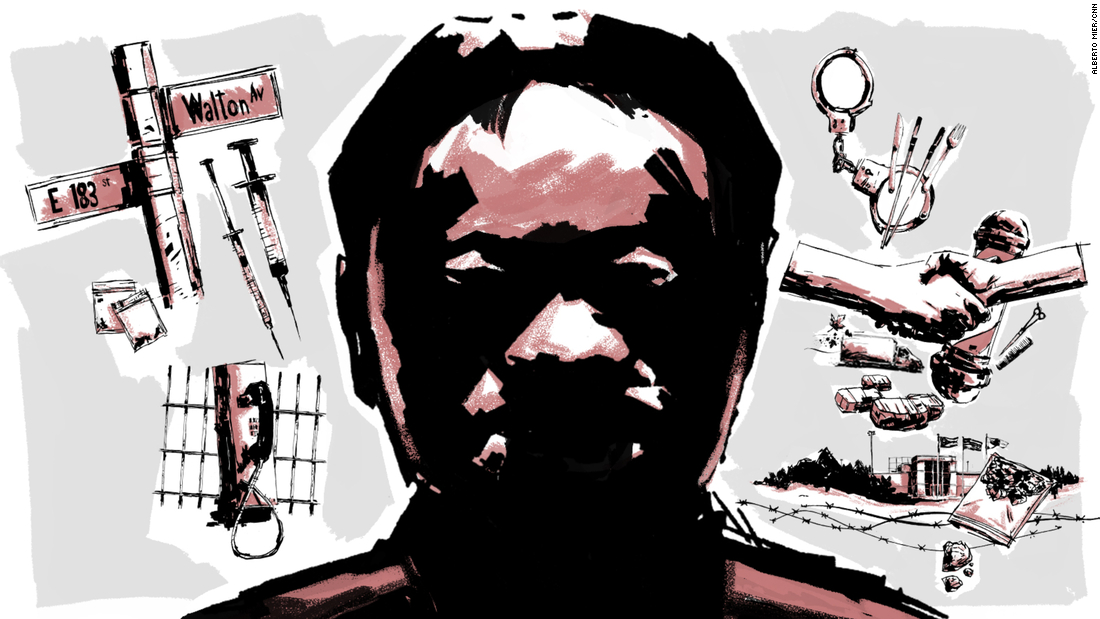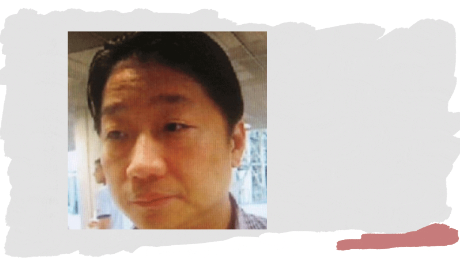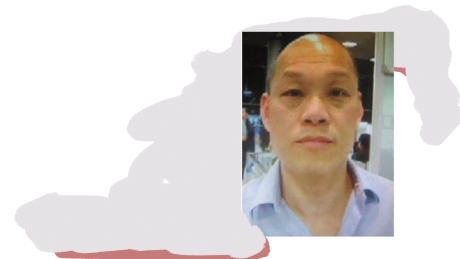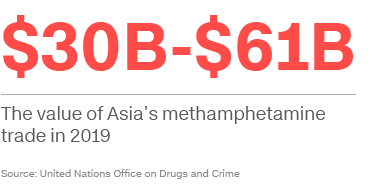With his black hair parted down the middle and modest fashion sense, Tse Chi Lop didn’t look like the head of a multinational operation that had flooded the streets of New York with heroin before his arrest on August 12, 1998.
And, as he sat in a spartan interrogation room in Hong Kong, he didn’t really behave like one, either.
Suspects usually reacted to arrest in one of two ways, the now-retired agent told CNN from his home in New Jersey. Combative types embraced the machismo that helped them navigate the cutthroat world of drug dealing. Cooperative ones worried that not talking meant longer prison time.
Tse didn’t do either. He was calm, friendly and strategically tight-lipped — even when Calnan told him the United States would be requesting his extradition.
Tse just smiled.
“He was impressive,” said Calnan. “He was different.”
By the end of that year, Tse was in New York, where he pleaded guilty to a single charge of conspiracy to import heroin into the US and was sentenced to nine years in prison. But if the authorities that put Tse behind bars were hoping he’d emerge from prison a changed man, it seems they were wrong.
Then in January this year, Tse was arrested at Amsterdam’s Schipol International Airport at the behest of Australian Federal Police (AFP), which had led a sprawling, decade-long investigation into his organization.
As prosecutors prepare their case against Tse, CNN has investigated his early years, to better understand the man Australian authorities claim is one of the most-successful meth masterminds of the 21st century.
This is the story of Tse’s first syndicate: how it thrived in American prisons; how police from around the world tore it apart; and how, from its ashes, this seemingly unassuming man from southern China was, allegedly, able to lay the groundwork for a multibillion-dollar drug empire from a prison in the foothills of the Appalachian Mountains.
To end what Republicans called in 1980 a “murderous epidemic of drug abuse” sweeping the country, the government had invested heavily in anti-drug policing and passed laws that toughened sentences for drug offenders.
But the tough mandatory minimum sentences for drug crimes and investments in policing were not having the desired effect.
That year, Calnan got a tip from a colleague about drugs being sold in the Bronx, on the corner of 183rd and Walton, and it would change his career. At the time, he was working for the FBI in New York, as a member of the Criminal Squad 25. C-25, as it was known, was tasked with tackling the growing problem of organized crime involving Asians and Asian-Americans — especially those dealing the heroin from Southeast Asia that was flooding into the US.
As Calnan and his team began to surveil the street corner, a few miles from Yankee Stadium, and identify suspects and tap phones, one name kept coming up: Sonny.
The problem was there were at least two suspects named Sonny. There was Sonny from New Jersey and Sonny from Leavenworth, the US penitentiary in Kansas. One was Sonny on the outside and — to their surprise — the other was Sonny on the inside.
Sonny on the outside, they learned, was a Malaysian heroin dealer living in New Jersey. Sonny on the inside was the boss, and he had figured out how to run a heroin business from a federal prison.
Yim Ling didn’t hear the assailants quietly enter her home in Kingston, New York, on a warm autumn day in 1983. She was in her bedroom, changing to go to work at her family’s Chinese tea house, when someone grabbed her from behind.
The government believes Yim was accidentally killed in the initial struggle, though her captors never mentioned that when extorting her husband for nearly $200,000 in ransom. Yim’s body was never found.
Authorities charged several people for the abduction, including Yong Bing Gong, then a 23-year-old former employee at Yim’s family tea house. Gong was sentenced to life in prison, where he became Sonny on the inside: the supplier for the heroin dealers on the New York street corner Calnan was monitoring.
Gong was cutting drug deals in the very place meant to punish people for dealing drugs.
Gong spoke to CNN through phone calls, letters and emails, though he declined to discuss specifics about his conviction on heroin trafficking charges, which were handed down while he was in prison. Gong hoped that sharing parts of his story would bring attention to what he feels are his unfairly long sentences. He was handed another 27 years in prison for heroin trafficking in addition to his first life sentence. After nearly 40 years behind bars, Gong believes he has paid his debt to society and should not be “left to rot and die, forgotten and forsaken by everyone I know.”
“I know I am not an angel, but I am still a human being,” Gong said.
Born in 1960 in Malaysia, Gong turned to a life of crime at a young age. His father owned a timber company in Indonesia and was often away, and his mother had six children — too many to focus on controlling her wayward son.
That left Gong, as he put it, to “run the streets.”
He joined a gang at 12 years old and eventually became a lieutenant. By 20 he was in a Malaysian jail, serving a two-year sentence after several run-ins with the law. Following his release in 1982, he went to the US.
Within about a year, he was in prison for Yim’s abduction.
At first, Gong found incarceration to be “mostly boredom and drudgery.” He needed something to spice up his day-to-day existence. So, after an introduction from another inmate, he turned to heroin dealing.
Flamboyant, talkative and somewhat brash, Gong was a born networker, and there was no better place to meet new clients than in prison. Gong would cut deals with other inmates, then coordinate with his contacts on the outside to sell the heroin over the prison phone system. Everyone spoke in code because the inmates’ calls are always recorded, though not always monitored.
Calnan’s investigation revealed that Gong was Sonny on the inside, supplying heroin to a Puerto Rican gang on the corner of 183rd and Walton Avenue in the Bronx. He was also Sonny from Leavenworth, which referred to the Federal Penitentiary in Leavenworth, Kansas, one of the oldest federal prisons in the US. It is one of several facilities that has held Gong since his sentencing in 1983.
Calnan’s team subpoenaed the prison tapes and cracked Gong’s code, which wasn’t terribly complex — sometimes it just meant referring to heroin as “menus” and dealers as “Chinese restaurants.” C-25 now had a major case on its hands, and like any major case, it needed a name.
They chose Sunblock, named after Sonny and the cell block they found him in.
The heroin Gong was dealing almost certainly came from the Golden Triangle, the historically lawless border region where Thailand, Laos and Myanmar meet.
Production surged in the 1960s, when these groups realized they could use labs to process poppy into stronger narcotics, such as morphine and heroin. And it continued to boom in the following decades.
People like Paul Kwok.
Though court records say Gong and Kwok met in prison, Gong told CNN they first crossed paths while living in New York in the early 1980s.
In 1983, Kwok, a Canadian national, was sentenced to federal prison in the US for heroin trafficking. By coincidence, he ended up in the same prison as Gong, and the two grew closer. Eventually, they went into business together.
As Kwok got closer to being eligible for parole, he was transferred to a Canadian prison before being released in 1990. He eventually began using his contacts to import heroin into Canada. Back then, it was easier to get illicit drugs past customs in Canada than in the US, according to Calnan. Kwok then moved the heroin across the US-Canada border, which in the early 1990s was less difficult to cross undetected than it is now.
In the US, Gong would use the network of customers he had developed in federal prison to find buyers.
The arrangement worked well. By the start of 1994, Gong and Kwok had so much heroin coming in they started looking for more ways to smuggle larger quantities into the US.
So Kwok turned to the Sicilian mafia in Montreal for help. The Sicilians agreed, for a fee, to hide Kwok’s heroin alongside their own drugs and drive all the contraband to a barbershop on Long Island. Kwok’s associates would then pick up their heroin there and bring it to Gong’s buyers.
When the FBI uncovered the Sicilian connection, Operation Sunblock became a major international case. Calnan and his team were now going after a global syndicate that involved multiple organized crime outfits. The stakes were higher.
Kwok appeared to be the man in charge, at least at first. He was stoic and serious, and appeared to command respect and deference in the criminal underworld. So Calnan and a US attorney assigned to the case went up to Canada to interview Kwok in prison to gauge whether he’d cooperate.
Talking proved dangerous. Shortly after Kwok was detained, two men approached his wife to ask if he was working with authorities. She then received “numerous threatening phone calls” warning her husband against saying anything to the police, she said in a letter to the judge hearing the case.
Later, a group of inmates who saw Kwok briefly in the company of law enforcement bashed his head against the wall in the jail bathroom, knocking him unconscious. Kwok’s attorney said his client was targeted because it appeared he was cooperating.
Still, Kwok decided to take the risk. He told a judge that he decided to offer information so he could get out of prison as early as possible to take care of his wife and young son.
Kwok and one of his lieutenants, it turned out, could give the FBI the identity of their supplier in Asia — an unassuming, 33-year-old Chinese-Canadian man with poor taste in fashion and hair parted down the middle.
His name was Tse Chi Lop.
Tse was born on October 25, 1963, in Guangdong province, southern China, before the start of the Cultural Revolution — the bloody movement in which Mao Zedong attempted to reassert his leadership over the Chinese Communist Party by radicalizing the country’s youth against anyone deemed disloyal.
After the upheaval of the Cultural Revolution and the chaotic dissolution of the Red Guards, as the young paramilitary groups were known, some formed an amorphous gang called the Big Circle Boys. It was this criminal group which Tse joined.
By the 1990s, the Big Circle Boys were major players in the Golden Triangle-North America heroin trade — and were fine cutting deals with almost anyone if there was good money to be made.
The syndicate’s decision to get into business with the Sicilian mafia impressed Calnan. Most Asian gangs in the US, he found, wouldn’t form partnerships like that. Tse approached his trade like a business, found value in new partnerships but was smart enough to try to stay under the radar.
“He used cooperation, he crossed borders. He thought outside the box, and we had to do the same thing or else we never would have caught him,” Calnan said. “We had to be as good as he was.”
After Kwok and Gong’s 1995 arrests, it would take Calnan and the Sunblock team nearly three more years to snare Tse, because he was purportedly in mainland China, which doesn’t have an extradition treaty with the US.
The FBI was seemingly out of options until 1998, when Calnan’s Canadian colleague got wind that Tse was traveling to Hong Kong. If police arrested him in the semi-autonomous Chinese city, which did have an extradition treaty with the US, Tse could potentially be sent to New York stand trial.
Calnan convinced the FBI to fly him and the Canadian agent to Hong Kong to assist with the arrest, and on August 12, the Hong Kong Police Department nabbed Tse at a local diner. Within months, he was in America.
Ceci Scott, the assistant US attorney on the case, recalled that after Tse landed in the US, his lawyer seemed eager to reach a plea agreement. Calnan believed Tse was doing everything he could to get quickly to Canada, where his wife lived with their two children that were born in the early 1990s — a daughter and a son who had a lung problem and breathing issues since birth.
While Tse wanted to cooperate enough to reduce his sentence, he wasn’t willing to reveal all. “I think he knew that we knew that he wasn’t telling us everything,” Scott said.
But the way Tse carried himself stuck with Scott. “I remember thinking, God, he’s just got the most unusual demeanor, a kind of a down-to-earth personality,” she said.
Eventually, Tse reached a deal with prosecutors that saw him plead guilty to conspiracy to import heroin into the US. Avoiding a trial allowed Tse to cut his prison time, and limit the amount of information that would exist in the public record. Today, the exact extent of his role in his first heroin syndicate remains a mystery. We don’t know how much heroin he supplied to Gong and Kwok, nor do we know if Kwok was his only customer. Calls to Kwok’s family and former attorney went unanswered.
Tse’s nine-year prison sentence was handed down on September 26, 2000, though he only ended up serving six. Prison would mark the start of a second chapter of Tse’s life, giving him the opportunity to learn from drug dealers in the US.
It was also where, allegedly, Tse met his next partner.
After driving through the lush greenery of the rural Appalachia, Tse would have arrived at the Federal Correctional Institution, in Elkton, Ohio, handcuffed, shackled at the feet and chained around his midsection.
Elkton is a low-security federal prison. It sits atop a hill and has a fence with wires to keep inmates from escaping into the surrounding pine trees. But inside, security precautions are not overwhelming, former inmates and staff say. Most convicts there are either non-violent offenders or people nearing the end of their sentences getting ready to reenter society.
“It was a different environment from multiple prisons I’ve been in,” said Charles King, a former inmate who arrived at Elkton in 2006, the year Tse left federal prison. “It was more open arms, more welcoming.”
King and others said the prison felt like a secure college campus. Inmates lived in one of several concrete-floored dormitory-style buildings with shared bathrooms and common space. Three or four men slept in small, crowded cubicles divided by cinderblock walls four to five feet high, easy enough to see over the top of.
By 2002, two years after his conviction and sentencing, Tse claimed to be almost penniless and requested a waiver for legal fees to file appeals or sentencing reductions. He said in court filings all he owned was $500 worth of clothes and $1,000 donated to him by friends and family, although it’s possible he chose not to report any holdings outside the US.
Prison was likely an adjustment for Tse, but if he was troubled those around him mostly didn’t see it. Ben, a pseudonym of a former Elkton inmate who spoke to CNN on the condition of anonymity, said Tse was “a pretty nice guy” who always had a big smile.
Other drug dealers in that prison wanted to make it known they were “big guys,” Ben said. Tse, by contrast, was pretty humble, Ben said, and didn’t really care about reputation or street cred.
Elkton housed about 1,500 prisoners during Tse’s tenure. Ben said there were about a couple of dozen inmates who were ethnically Chinese, and most spoke Cantonese. Tse was one. Another was Lee Chung Chak.
Lee had snuck into the US across the Canadian border on July 4, 1994, to coordinate what was supposed to be a major heroin deal, but the FBI were on to his associates.
Though Tse told the US government he planned to open a restaurant once out of prison and expressed “great sorrow” over his criminal past, he and Lee purportedly had their sights on methamphetamine.
Sam Gor is believed to be made up of former rival triads who united in the name of making money, as Tse and Kwok did with the Sicilian mafia. Together, these gangs allegedly manufactured synthetic drugs on an industrial scale in large swathes of the under-policed jungles of Myanmar, the same place where Tse allegedly sourced his syndicate’s heroin in the 1990s.
Sam Gor’s purported strategy was simple: make enough meth to create an economy of scale and drive down the cost-per-unit. Then flood the market with this cheap and addictive product to get new customers, and watch the money pile in.
The human cost has been “devastating,” said Jeremy Douglas, the regional representative for Southeast Asia and the Pacific at the United Nations Office on Drugs and Crime (UNODC).
The number of reported users in countries like Indonesia, Thailand and Vietnam have increased significantly since 2015, according to figures from the UNODC. More than 206,000 people across Southeast Asia sought treatment for methamphetamine use in 2020, but the real number of addicts is likely much higher because of the stigma surrounding addiction. Many people who want help choose to avoid treatment, or they simply may not have access to the same resources they would in Western countries.
Lee’s lawyer did not respond to CNN’s request for comment.
Putting them behind bars was a tremendous achievement. But the meth has continued to flow without them.
When Scott, the US attorney who helped put Tse in prison, heard about his arrest in January, she winced.
“We had no information about him doing anything with meth,” recalled Scott, who no longer works at the Justice Department. “Obviously, he met people.”
Scott loved her job as assistant US attorney for the Eastern District of New York but said drug cases sometimes left her conflicted, especially in a liberal city like New York.
By the late 1990s, the painful unintended consequences of the war on drugs were becoming clear. Tough punishments meant to deter would-be drug users and dealers had flooded American prisons with non-violent offenders, the majority of whom were from minority communities.
“A lot of the prosecutors in that office were questioning how effective those laws were,” Scott said.
Incarceration is meant to punish criminals and protect society from them, but it’s also meant to rehabilitate them.
Instead, the war on drugs created a vicious cycle. Drug dealers went to prison for years thanks to tough sentencing laws. Limited resources were dedicated to getting criminals to change their ways. So prison ended up offering convicts the opportunity to network and learn from each other.
Academics in Denmark who analyzed the country’s entire prison population found in 2020 that for criminals sentenced to prison for drug offenses, there was “strong evidence of reinforcing peer effects on recidivism” — that is, drug dealers who met other drug dealers in prison learned from each other and ended up back in jail.
Calnan said he did a double take when the name of the man who calmly sat across from him in Hong Kong popped up in the news more than two decades after their meeting. He hadn’t given Tse another thought after his conviction in 2000.
He never thought Tse would, allegedly, become “one of the biggest international drug dealers of all time,” Calnan said.
“Looking back on it, it’s not surprising at all,” Calnan said. “He (Tse) had the skills, and of course time in prison is networking like crazy.”
Calnan realized later that the moderately successful heroin dealer he put behind bars was smart enough to run a criminal empire, and savvy enough to know how to use prison to his advantage.
“(Sunblock) begins with guys in prison networking,” Calnan said. When it came to Tse Chi Lop, Calnan said: “I don’t doubt … that’s exactly what he did also.”








